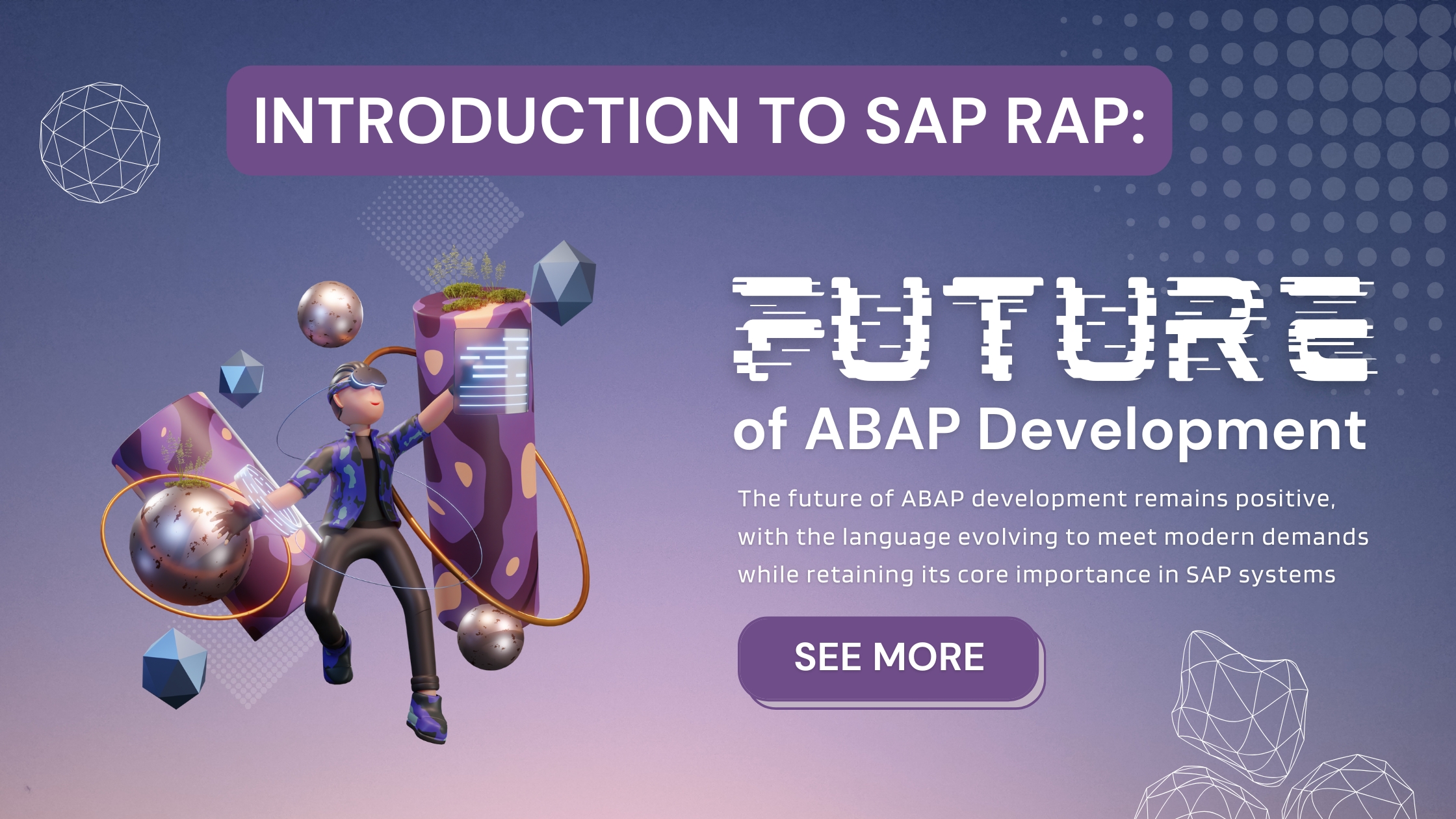- Home
- Blog Details
Introduction to SAP RAP: The Future of ABAP Development
In today’s fast-changing tech world, it is important to keep up with the latest tools. For developers working within the SAP ecosystem, the SAP RESTful Application Programming Model (SAP RAP) is a game-changing approach that modernizes how applications are developed on the SAP Business Technology Platform ( BTP) and SAP S/4HANA. RAP is not just another development model; it represents the future of ABAP development.
SAP RAP helps developers create powerful and flexible business apps that work well both in the cloud and on-premises systems.
What is SAP RAP?
SAP RAP (RESTful Application Programming Model) is a framework that enables making it easier to build business apps using ABAP. It supports both transactional and analytical applications and is optimized for use with SAP S/4HANA and SAP BTP ABAP Environment.
RAP enables the creation of OData services in a standardized, reusable, and scalable way. It combines the power of modern ABA, core data services (CDS), business objects, and Fiori elements to deliver a powerful development model.
Why is SAP RAP the future?
- Built for the cloud
SAP RAP is designed with the cloud in mind. With SAP moving steadily towards RISE with SAP and SAP S/4HANA cloud, it is positioned as the go-to model for creating cloud-native apps using ABAP.
- Easy to use with Fiori apps
RAP applications integrate natively with SAP Fiori, making it easier to build responsive, user-friendly interfaces. It reduces the effort of building UIs from scratch by leveraging Fiori elements that auto-generate the UI based on metadata.
- Safe and organized
SAP RAP separates the data model, behavior logic, and service exposure, creating a clear architecture that is easy to manage and secure. Developers can define behaviors, validations, authorizations, and more in a centralized and scalable manner.
- Clean code and modern tools
RAP promotes clean code principles and supports modern development practices such as automated testing, CI/CD, and modular development. This improves code quality and simplifies the transition to DevOps methodologies.
The Future of SAP Development with RAP
As enterprises transition to SAP S/4HANA Cloud, there is growing demand for scalable, maintainable, and cleanly architected applications. Traditional ABAP development was efficient in its time, but it falls short when it comes to cloud readiness and UI consistency.
RAP ensures that applications are designed in a modular, layered structure, making them easier to test and extend. This reduces technical debt and ensures long-term sustainability os custom-built UIs.
Key components of SAP RAP
- Core data services (CDS) Views
CDS views define the data model and are an important part of SAP RAP applications. They help represent business data logically and support annotations for Fiori UI generation and analytics.
- Behavior definition and binding
RAP introduces a behavior definition to describe what actions, validations, or logic a business object should have. Implementations are then done in ABAP classes, keeping logic separate from the data layer.
- Service definition and binding
After defining behaviors, you expose them as OData services using service definitions and service bindings. This is how you make your application accessible to the UI or external systems.
- Fiori elements
RAP works seamlessly with Fiori Elements, which auto-generates UIs based on metadata. This saves a lot of time and ensures a consistent user experience.
Who should learn SAP RAP?
SAP RAP is ideal for:
- ABAP developers are looking to future-proof their skills.
- SAP S/4HANA consultants who want to understand app extensions.
- SAP BTP developers are working on side-by-side or in-app extensions.
- Tech-savvy functional consultants interested in Fiori and backend logic.
With RAP becoming the standard, enrolling in a SAP RAP course can significantly boost your career opportunities.
Getting Started: Learning SAP RAP
- Learn the basics of ABAP and CDS views
Make sure you have a good grasp of modern ABAP syntax and Core Data services (CDS).
- Understand the RAP architecture
Familiarise yourself with how RAP apps are structured, the data model, the behavior layer, and the service layer.
- Explore Fiori elements and OData
Learn how RAP uses annotations to generate Fiori UIs
- Take a SAP RAP course
Enroll in a structured SAP RAP course offered by SAP learning hub, open SAP, or third-party platforms to gain hands-on experience.
- Practice in SAP BTP ABAP Environment
Try building sample applications using SAP’s trial environment or a sandbox system to get real-world practice.
Where RAP is used in real life ?
- Sales order management: create, update, and track sales orders.
- Employee self-service apps: build modern HR applications with UI5 frontends.
- Product catalogs: develop catalogs with filters, pricing logic, and analytics.
- Custom reports and dashboards: combine transactional and analytical CDS views for real-time reporting.
Benefits of SAP RAP for Businesses
- Help build apps that are easier to update.
- Lower development and maintenance costs.
- It supports both on-premise and cloud systems.
- Better user experiences through consistent Fiori apps.
- Easier integration with SAP and third-party systems.
Conclusion: Embrace the Future with RAP
SAP RAP is more than just a new way to develop in ABAP; it is a complete shift in how enterprise applications are built. It aligns perfectly with SAP’s cloud-first vision and offers scalability, security, and performance. If you are serious about SAP development, now is the time to dive into RAP. With many businesses moving to SAP S/4HANA and SAP BTP, knowledge of RAP will set you apart from other professionals.
Start by exploring a SAP RAP course and complement your skills with a comprehensive SAP course to become a full-stack SAP developer.


